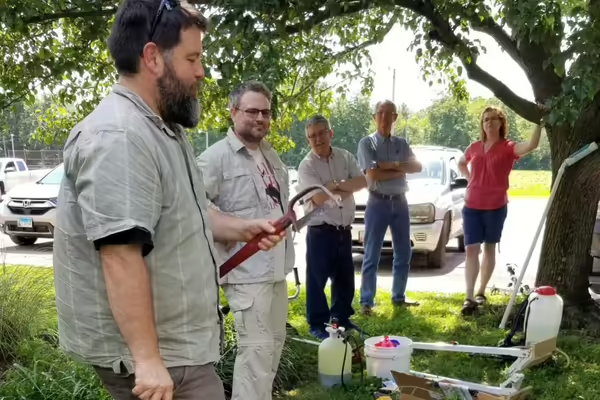
URBANA, Ill. — From your backyard to the local forest, invasive species have big environmental and economic impacts. Learn how to manage invasive plants in Introduction to Invasive Species Management, a two-day hybrid program led by University of Illinois Extension educators that starts with a day of online learning on Aug. 5, followed by a regional hands-on field day available from Aug. 6-9.
At the online learning day, participants will explore the basics of invasive species ecology, invasive plant identification, and management principles. The field days are an opportunity to get an understanding of invasive species in the region, identify plants, review commonly used management tools, and see demonstrations of management techniques. The six statewide field day options include:
Aug. 6: St. James Farm Forest Preserve, Warrenville
Aug. 7: Allerton Park, Monticello
Aug. 7: Chinquapin Bluffs Land and Water Reserve, Carlock
Aug. 8: Lincoln Prairie Trail, Taylorville
Aug. 8: John Wood Community College, Quincy
Aug. 9: Jackson County Illinois Extension Office, Murphysboro
This program is open to early-career natural resource professionals, landowners, volunteers, students, and anyone interested in gaining experience managing invasive species. Participants will obtain a certificate of course completion from Illinois Extension for attending both days. The $20 registration fee includes lunch on the field day. There are a limited number of spots available for each field day. Sign up by Aug. 4 at go.illinois.edu/IntroInvasives.
If you need a reasonable accommodation to participate, contact Chris Evans at (618) 695-3383 or cwevans@illinois.edu. Early requests are strongly encouraged to allow sufficient time to meet access needs.
Non-native invasive species are plants, animals, and insects that spread quickly, cause ecological or economic damage, and are hard to remove once established. Illinois' centralized location and extensive transportation networks provide many ways for pests to arrive. Across the state, Illinois Extension staff and volunteers work with communities to identify potential invasions, remove invasive species, and restore natural areas. Explore more about invasive species at go.illinois.edu/Invasive.
To connect with Extension natural resources, environment, and energy staff about a program or for a consultation, visit go.illinois.edu/NREEstaff. Extension’s natural resources, environment, and energy program provides research-based education for awareness and action to sustain healthy environments and ecosystems that support quality living and resilient communities. Extension staff empower people across Illinois to make a difference through the Master Naturalists, Climate Stewards, and Watershed Stewards volunteer and training programs.
University of Illinois Extension develops educational programs, extends knowledge, and builds partnerships to support people, communities, and their environments as part of the state's land-grant institution. Extension serves as the leading public outreach effort for University of Illinois Urbana-Champaign and the College of Agricultural, Consumer and Environmental Sciences in all 102 Illinois counties through a network of 27 multi-county units and over 700 staff statewide. Extension’s mission is responsive to eight strategic priorities — community, economy, environment, food and agriculture, health, partnerships, technology and discovery, and workforce excellence — that are served through six program areas — 4-H youth development, agriculture and agribusiness, community and economic development, family and consumer science, integrated health disparities, and natural resources, environment, and energy.